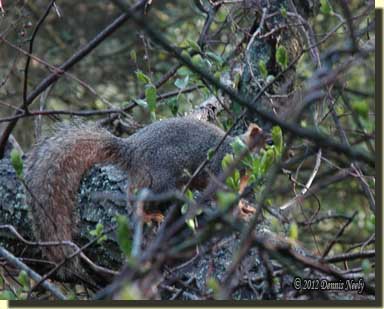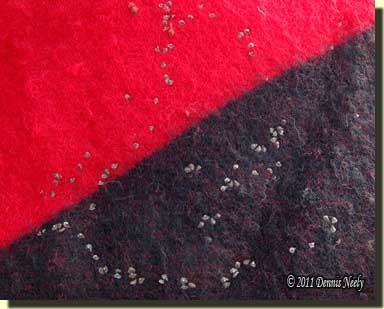Oak leaves rustled. A fox squirrel bounded to a powder-keg-sized red oak. Dirt and duff flew as the forest tenant dug unaware danger lurked so close. Its bushy tail twitched and flicked, but alas, if found nothing.

Next, the squirrel hopped to a dead cedar tree that curved to the earth. The squirrel scampered to the crest of the cedar’s arch, stopped and began chattering. It sat for quite a while, looking, barking, watching…
Not far off on that Monday evening, in the Year of our Lord, 1795, Msko-waagosh hid in a tangle of oak branches. The quest that day was wild turkeys, not squirrels. The air smelled of drying field corn and impending rain. The returned white captive, who spent his youth among his adoptive Ojibwe family, busied himself pinching and twisting sticktights from his trail-worn wool leggins.
The still-hunt down the steep slope and into the little valley consumed the woodsman’s concentration. Hens and gobblers on their way to the roost passed close to the monarch oak that stood in the midst of the hollow. He never saw the cluster of clutching beasties that even burrowed into the tattered silk ribbons adorning the blue-wool flaps. Pinch and pull…glance about…pinch and pull…
A chipmunk scampered back and forth, two trade gun lengths to the right. The leggins cleaned, attention turned to the sticktights that dotted the hem of the yellow linen outer shirt. Red Fox fought the urge to toss the seeds aside; he despised planting them as the Lord intended, only to grow and torment him next season. Instead, he tucked the prickly brown nuisances into a small deerskin pouch. He always smiled when he tossed them into the evening fire…
Dealing with Sticktights
Sticktight season begins when chilly fall mornings become the norm. The North-Forty always seems to be ten degrees colder than the homestead, especially if a jaunt hovers close to the big swamp, the nasty thicket or the River Raisin’s bottomlands.

A wool trade blanket, worn over the left shoulder and under the right, is a must from late-October on through the winter. Despite being folded in half, the tails reach to my alter ego’s knees, low enough to brush every sticktight sprig in the glade. I swear, they pull up roots and sidle over to whatever path that day’s character chooses.
If I pick them as soon as they leap onto anything wool or linen, they are easier to remove. After a couple of days, they burrow deep into the weave. I’ve never come across any way to clean them out, other than plucking them one-by-one.
Our spring is colder than normal this year. That isn’t a surprise, given the warmer, wetter winter past. Mi-ki-naak has hunted only twice without his walnut-dyed wool blanket this spring, which is not normal along the Riviere Aux Raisins. The other evening’s still-hunt slipped into that same hollow. Snapping Turtle sat with his back against a fair-sized red cedar tree, overlooking the monarch oak. Out of habit, his hands ran along the blanket’s hem as he tucked it in around his body.
Distress of distresses! A passel of sticktights gripped the right-side blanket corner. Pinch and pull…glance about…pinch and pull…look… The same routine that is followed in the fall cleaned the blanket’s edge. But as he sat, this is the first time the veteran woodsman can remember encountering sticktights in the spring. Lots of wood ticks, yes; lots of mosquitoes, yes; sticktights, no.
There is only one solution: “Toss them into the evening fire!”
Give traditional black powder hunting a try, be safe and may God bless you.



One Response to Toss them into the evening fire!